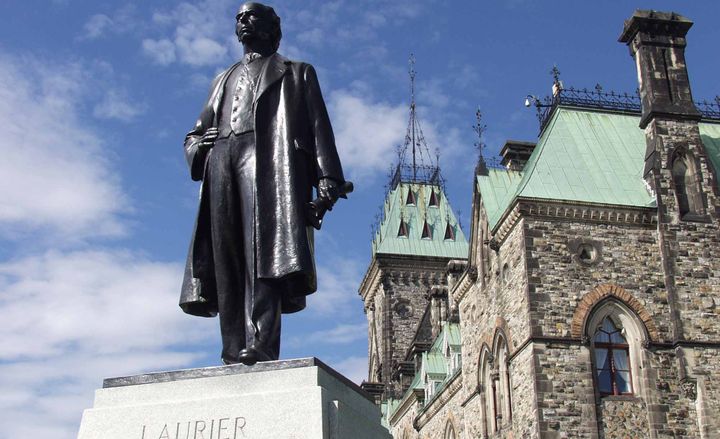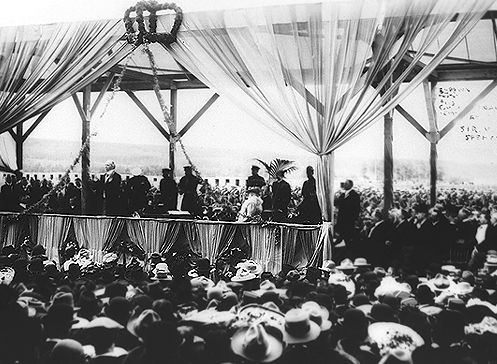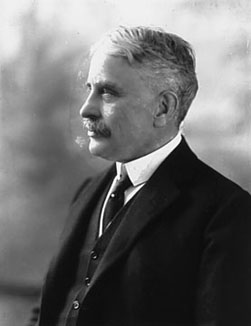Sir Wilfrid Laurier
Sir Wilfrid Laurier, prime minister of Canada 1896–1911, lawyer, journalist, politician (born 20 November 1841 in St-Lin, Canada East; died 17 February 1919 in Ottawa, ON ). As leader of the Liberal Party 1887–1919 and prime minister 1896–1911, Laurier was the dominant political figure of his era.

-
November 20, 1841

Sir Wilfrid Laurier
Birth of Wilfrid Laurier
Prime minister Sir Wilfrid Laurier, who was the first French Canadian prime minister and who held the longest unbroken tenure as PM, was born at St-Lin, Canada East.
-
July 01, 1867

Sir Wilfrid Laurier
Canada Comes Into Existence
The Dominion of Canada came into existence, consisting of Ontario, Québec, Nova Scotia and New Brunswick.
-
May 13, 1868
Sir Wilfrid Laurier
Wilfrid Laurier Marries
Wilfrid Laurier married Zoé Lafontaine in Montréal. The marriage was almost not to be. Laurier left Montréal for health reasons, thinking he had tuberculosis. Lafontaine began to see another man, planning to marry him. Laurier returned, learned he was not tubercular and rushed to see Lafontaine. They married that night.
-
November 16, 1885

Sir Wilfrid Laurier
Louis Riel Hanged
Louis Riel was hanged for treason at the Regina jail. He had been convicted after a trial held in Regina from 28 July to 1 August. Macdonald's refusal to grant leniency made Riel a symbol of English-Canadian oppression.
-
June 07, 1887
Sir Wilfrid Laurier
Laurier Chosen Leader
Wilfrid Laurier was chosen leader of the Liberal opposition in Parliament, succeeding Edward Blake.
-
June 23, 1896

Sir Wilfrid Laurier
Liberal Victory, Laurier PM
In the federal election, the Liberals defeated the Conservatives with 118 seats to 88. Wilfrid Laurier became Canada's first French-Canadian prime minister and marked a turning point in Canadian politics after years of Conservative Party rule.
-
October 18, 1899

Sir Wilfrid Laurier
Bourassa Resigns
Henri Bourassa resigned his seat in Parliament to protest Canada's involvement in a British colonial war (the South African War).
-
October 30, 1899

Sir Wilfrid Laurier
First Canadians to South Africa
The first Canadian troops (2nd Battalion, Royal Canadian Regiment, with 57 officers and 1224 men commanded by W.D. Otter) set sail from Québec for South Africa.
-
January 21, 1900

Sir Wilfrid Laurier
More Canadians to South Africa
A second contingent of Canadian troops sailed for South Africa to fight in the Boer War.
-
November 07, 1900

Sir Wilfrid Laurier
Liberals Hold Power 1900
In the federal election, the Liberals were sustained in power, with 132 seats to the Conservatives' 81. Laurier remained prime minister.
-
September 16, 1901
Sir Wilfrid Laurier
Duke and Duchess Visit Québec
The Duke and Duchess of York visited Québec City and were welcomed by Prime Minister Wilfrid Laurier and Québec Premier Simon-Napoléon Parent.
-
May 24, 1902

Sir Wilfrid Laurier
First Victoria Day
The first Victoria Day was observed throughout Canada. PM Wilfrid Laurier designated the holiday to fall on the birthday of Queen Victoria.
-
May 31, 1902
Sir Wilfrid Laurier
South African War Ends
The Boer War between Britain and the Boer states ended with the treaty signed at the South African town of Vereeniging.
-
December 18, 1902
Sir Wilfrid Laurier
Ministerial Conference
Prime Minister Wilfrid Laurier arrived at Québec City to attend a ministerial conference. Premier and city mayor Simon Napoléon-Parent was particularly interested in addressing the matter of trans-Canadian railways.
-
October 20, 1903

Sir Wilfrid Laurier
Alaska Boundary Dispute
Settlement of the Alaska-Canada boundary dispute established the Alaska-Canada border as it is today. The border denied Canada access to the sea in both northern BC and the Yukon.
-
November 03, 1904

Sir Wilfrid Laurier
Liberals Retain Power 1904
In a federal election, the Liberals maintained power, with 139 seats to the Conservatives' 75. Laurier remained prime minister.
-
July 18, 1905

Sir Wilfrid Laurier
Dominion Act
The Dominion Act created the provinces of Alberta and Saskatchewan, effective September 1. Regina and Edmonton, respectively, became the capitals on July 20.
-
September 01, 1905

Sir Wilfrid Laurier
Alberta and Saskatchewan Become Provinces
Alberta and Saskatchewan entered Canada as the 8th and 9th provinces by two federal Acts which received royal assent on 20 July. Alberta's boundary with Saskatchewan was set at 110°, though Albertans wanted 107°. The Acts (Autonomy Bills) declared that the West was to have non-denominational schools.
-
November 24, 1905

Sir Wilfrid Laurier
Canadian Northern Completed
The Canadian Northern Railway was completed to Edmonton.
-
May 17, 1906
Sir Wilfrid Laurier
Grand Trunk Pacific Railway Begun
Construction on the Grand Trunk Pacific Railway began at Prince Rupert with the construction of a tool shed and the erection of tents as accommodation.
-
October 26, 1908

Sir Wilfrid Laurier
Liberals Retain Power 1908
In a federal election, the Liberals remained in power with 133 seats to the Conservatives' 75. Laurier remained prime minister.
-
May 04, 1910

Sir Wilfrid Laurier
Naval Service Act
The Canadian Navy began as the Canadian Naval Service when the Naval Service Act was passed. Canada has sent over 850 warships to sea since its creation.
-
August 15, 1910
Sir Wilfrid Laurier
Vancouver Exhibition Opens
The Vancouver Exhibition (now Pacific National Exhibition) opened to the public for the first time. PM Wilfrid Laurier presided over the official opening on August 16.
-
September 21, 1911

Sir Wilfrid Laurier
Conservatives Back in Power
In a federal election, the Conservatives under Robert Borden's leadership returned to power, winning 133 seats to the Liberals' 86. Laurier's Liberals had been in power since 1896. The election was a defeat for the Liberals' policy of free trade.
-
October 11, 1911

Sir Wilfrid Laurier
Borden Becomes Prime Minister
Robert Borden became prime minister, ending Laurier's 15-year rule.
-
November 17, 1913

Sir Wilfrid Laurier
National Transcontinental Complete
The last spike was driven on the National Transcontinental Railway, which had begun work in 1903 and ran from Winnipeg, via Sioux Lookout, Kapuskasing, Cochrane and Québec City, to Moncton, NB.
-
April 07, 1914
Sir Wilfrid Laurier
Grand Trunk Pacific Completed
The Grand Trunk Pacific Railway was completed to Nechako, BC. The first train arrived at Prince Rupert on April 9.
-
August 04, 1914

Sir Wilfrid Laurier
Canada and Newfoundland Enter the First World War
After Britain’s ultimatum to Germany to withdraw its army from Belgium expires at midnight on the third, the British government declares war on Germany the next day. As dominions of the British Empire, Canada and Newfoundland are also at war.
-
January 23, 1915

Sir Wilfrid Laurier
Canadian Northern Railway
The last spike was driven on the Canadian Northern Railway at Basque, BC.
-
May 18, 1917

Sir Wilfrid Laurier
Borden Announces Conscription
Sir Robert Borden announced his decision in Parliament to implement Conscription. The imposition of conscription on reluctant French Canadians was a failure and bitterly divided the country along French-English lines.
-
August 29, 1917
Sir Wilfrid Laurier
Military Service Act
The Military Service Act was passed, making most male British subjects up to 45 years of age liable for active military service (Conscription).
-
March 28, 1918
Sir Wilfrid Laurier
Anti-conscription Riots
Anti-conscription riots began in Québec City.
-
November 11, 1918
Sir Wilfrid Laurier
Armistice
The Armistice with Germany ended First World War. A total of 628,562 Canadians served in the Canadian armed forces, including 424,589 who went overseas; 60,661 were killed.
-
February 17, 1919

Sir Wilfrid Laurier
Death of Laurier
Sir Wilfrid Laurier died at Ottawa.
